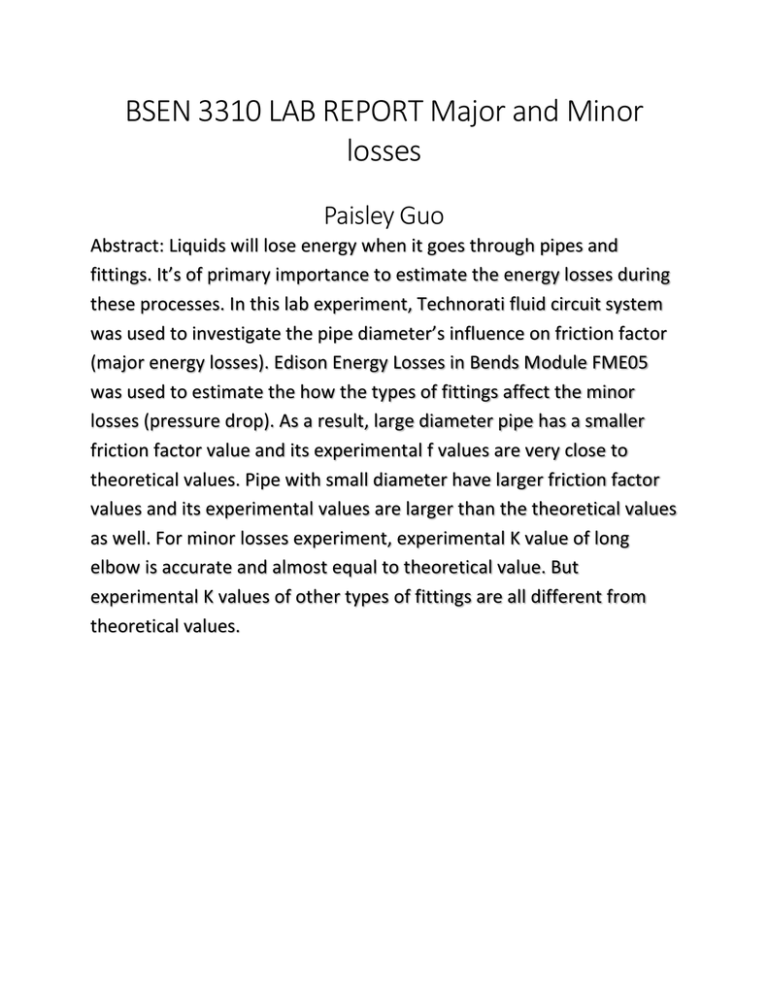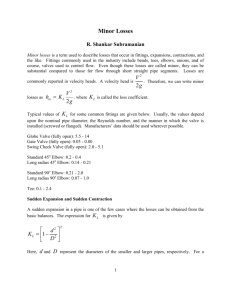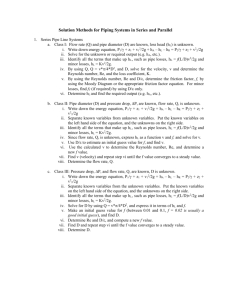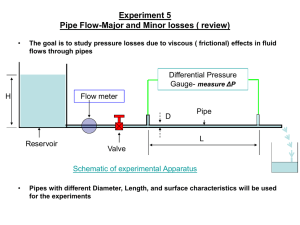Fluid Flow Losses Lab Report: Major & Minor Analysis
advertisement

BSEN 3310 LAB REPORT Major and Minor losses Paisley Guo Abstract: Liquids will lose energy when it goes through pipes and fittings. It’s of primary importance to estimate the energy losses during these processes. In this lab experiment, Technorati fluid circuit system was used to investigate the pipe diameter’s influence on friction factor (major energy losses). Edison Energy Losses in Bends Module FME05 was used to estimate the how the types of fittings affect the minor losses (pressure drop). As a result, large diameter pipe has a smaller friction factor value and its experimental f values are very close to theoretical values. Pipe with small diameter have larger friction factor values and its experimental values are larger than the theoretical values as well. For minor losses experiment, experimental K value of long elbow is accurate and almost equal to theoretical value. But experimental K values of other types of fittings are all different from theoretical values. Introduction: Fluid circuit system is a system comprising an interconnected set of discrete components that transport liquid. In this experiment, the fluid circuit system used contains 2 orifice sections and 2 pipe sections. It was used to measure the major losses caused by pipe diameter. Edibon energy losses in bends module FME 05 contains several types of fittings attached to a 20 mm ID line. It was used to measure the minor losses in pipes. Head loss In any real moving fluid, energy is dissipated due to friction; turbulence dissipates even more energy for high Reynolds number flows. This dissipation, called head loss, is divided into two main categories, "major losses" associated with energy loss per length of pipe, and "minor losses" associated with bends, fittings, valves, etc. The most common equation used to calculate major head losses is the Darcy–Weisbach equation. Older, more empirical approaches are the Hazen-Williams equation and the Prony equation. For relatively short pipe systems, with a relatively large number of bends and fittings, minor losses can easily exceed major losses. In design, minor losses are usually estimated from tables using coefficients or a simpler and less accurate reduction of minor losses to equivalent length of pipe. Major loss Major losses, as the name implies, are the largest contributor to head loss in most piping systems. These losses are illustrated in the pressure drop over a long section of pipe. Friction between fluid molecules as well as friction between the fluid and the walls of the pipe generates the head loss associated with major losses. These losses have been better conceptualized over the decades of deriving the basic formulations for pipe flow and are used as basis of comparison for minor losses in fittings using the equivalent length method. Minor loss Minor losses are produced in the inlets, exits, bends, valves and fittings of a piping system. Though generally less impactful to head loss as major losses, minor losses can be greater than major losses in small piping systems with many turns and valves. The interruption of flow caused by restriction or changes of flow direction cause these losses through mixing and flow separation. Minor losses have been difficult to model compared to major losses due to the vast variation of designs of valves, tees, and elbows. Objective: The target of this lab experiment was to measure how the pipe diameter affects the friction factor (major losses) in pipes and also the effect of fitting type on minor losses. Materials and methods: Equipment used in this lab: Technovate fluid circuit system and Edibon Energy Losses in Bends Module FME05 Experimental procedure: Major losses: Valve 52 was used to control the flow rate in the system and change the flow went through 40mm diameter pipe and 2 mm diameter pipe. The reading for the 2 pipe sections and 2 orifice section were obtained. 6 different flow rates used obtained by adjusting valve 52. For each flow rates, the flow rate readings of the 2 pipe sections (1.025 inches ID and 0.430 inches ID) as well as the 2 orifice section readings were recorded for analysis. Minor losses: Edibon Energy Losses in Bends Module was used to estimate the minor losses. Flow rates were changed by controlling the valve. 6 flow rates were measured and the corresponding pressure reading were recorded. In the last measurement, pressure drop of tap 12 was about 0 inches of water. The flow rate was measured by fixing the time needed for the flow to fill up a certain volume container. Data analysis: Major losses: The pressure drop across orifice was used to calculate volumetric flow rate through the pipe by using the following equation: Where, Q: volumetric flow rate; Ao: cross section area; Cd: discharge coefficient, in this case Cd=0.656; Porifice: pressure drop across orifice; P: density of the flow; β: ratio of hole diameter to pipe diameter, β =d/D. For each flow rate and each pipe, Darcy friction factor (f) was calculated from the following equation: Where, V: flow velocity, V=Q/A; A: X-sectional area; L: length; D: diameter of the pipe; f: Darcy friction factor; g: gravity acceleration. Theoretical values of f were calculated using the following equation: Where, f is the Darcy friction factor, ε is the roughness value, D is the diameter of the pipe, Re is the Reynold number. This theoretical f value is calculated using Matlab program. Finally, experimental and theoretical f versus v2 were plot and conclusion was obtained. Minor losses: K values can be obtained by using the following equation. Where, hf is the pressure drop across the fitting, V is the velocity of flow, g is the gravity acceleration. The trendline (with intercept of zero) of plot of pressure drop across each fitting hL versus V2 was used to estimate K values for each fitting. Theoretical K values were obtained based on the following equation. A tables contains experimental and theoretical K values can indicate the results of this experiment. Results and Discussion: Major losses: Figure 1 illustrates the plot of experimental f values versus v2of pipe with 1.025 inches ID. As it’s shown in the figure, the experimental f values are not far away to the theoretical values, especially at high flow velocities. With the flow velocity increasing, the experimental f values become closer and closer to theoretical values. Results of 1.025 inches ID pipe indicate the theoretical calculation formula and the theory from which the equation was obtained is accurate. Pipe with 1.025 inches ID 0.035 friction factor 0.03 0.025 0.02 0.015 experimental friction factor 0.01 theoretical friction factor 0.005 0 0 0.2 0.4 0.6 0.8 1 Square of flow velocity(m^2/s^2) Figure 1 Experimental and theoretical friction factor values Versus square of flow velocity for 1.025 inches ID pipe Figure 2 shows the plot of experimental and theoretical f versus square of flow velocity of pipe with 0.43 inches ID. As the figure indicates, there are some differences between experimental and theoretical f values. Experimental values are all larger than theoretical values. Pipe with 0.43 inches ID 0.035 friction factor 0.03 0.025 0.02 0.015 experimental friction factor 0.01 theoretical friction factor 0.005 0 0 1 2 3 4 5 6 Square of flow velocity(m^2/s^2) Figure 2 Experimental and theoretical friction factor values Versus square of flow velocity for 0.43 inches ID pipe As a result, experimental f values for large diameter pipes are closer to theoretical f values than small diameter pipes. Using hydraulic transport viewpoint, there is a stagnation layer in the pipe, the thickness of the stagnation layer determine the energy losses in the pipe. If the diameter of pipe is small, the ratio of the thickness of stagnation layer to the diameter of the pipe with be larger. That is to say, a lot more flow will lose its energy to the pipe wall. The theoretical formula does not take that part into account and results in the inaccuracy of theoretical values to experimental values and this tendency is more obvious at low flow velocities. Minor losses: The K value was obtained from the plot of hf versus V2. The slope of the plot equals to K/2g. The following plots (Figure 3) show the relationship of hf and V2 for long elbow, sudden enlargement from 20mm to 40mm ID, sudden contraction from 40mm to 20mm, medium elbow, short elbow, and right angle fittings. 0.014 y = 0.0139x Pressure drop(m) 0.012 0.01 0.008 0.006 Long elbow 0.004 linear 0.002 0 Pressure drop(m) 0 0.2 0.4 0.6 Square of velocity(m^2/s^2) 0.01 0.009 0.008 0.007 0.006 0.005 0.004 0.003 0.002 0.001 0 0.8 1 y = 0.0098x Sudden enlargement from 20mm to 4omm linear 0 0.2 0.4 0.6 0.8 1 Square of velocity(m^2/s^2) 0.03 y = 0.0299x Pressure drop(m) 0.025 0.02 Sudden contraction from 40mm to 20mm linear 0.015 0.01 0.005 0 0 0.2 0.4 0.6 Square of velocity(m^2/s^2) 0.8 1 0.014 y = 0.0141x Pressure drop(m) 0.012 0.01 0.008 0.006 Medium elbow 0.004 linear 0.002 0 0 0.2 0.4 0.6 0.8 1 Square of velocity(m^2/s^2) 0.03 y = 0.0281x Pressure drop(m) 0.025 0.02 0.015 Short elbow 0.01 linear 0.005 0 0 0.2 0.4 0.6 0.8 1 Square of velocity(m^2/s^2) 0.045 Pressure drop(m) 0.04 y = 0.0433x 0.035 0.03 0.025 Right angle fitting 0.02 liear 0.015 0.01 0.005 0 0 0.2 0.4 0.6 0.8 1 Square of velocity(m^2/s^2) Figure 3 plots of hf versus V2 for different fittings Figure 3 shows the relationships of hf and V2 are linear, which is in consistence with the theoretical equation Different K values reflect different type of fittings. At the same flow velocity, the larger the K value, the more pressure drop (minor energy losses). Table 1 illustrates the experimental K values and theoretical K values obtained from textbook. From the table, the experimental and theoretical K values for long elbow is close to each other. Experimental K value for sudden enlargement from 40 mm to 20mm ID is larger than theoretical value. While for sudden enlargement from 20 mm to 40mm ID, medium elbow, short elbow and right angle fittings, the experimental K values are smaller than the theoretical values to some degree. The differences may come from experimental errors and system errors. There is a resistance when the liquid flow changes its direction. Since all liquids have weight, they also have momentum. This means the liquid will always try to continue moving in the same direction. When the liquid encounters a change in direction, its momentum will enforce the flow to the outer edge of the fitting. Because the liquid is trying to flow around the outer edge of the fitting, the effective area of the fitting is reduced. Thus, there will be minor losses within the system. For different kinds of fittings, the K value varies because of their material and structure differences. The sequence of K values of experimental data is: right angle fittings>sudden contraction from 40mm to 20mm ID>short elbow>medium elbow>long elbow>sudden enlargement from 20mm to 40mm. However, the sequence of theoretical values should be right angle fittings>short elbow>sudden contraction from 20mm to 40mm ID>medium elbow >sudden enlargement from 20mm to 40mm>long elbow. long elbow (1 & 2) Experimental valves of K 0.27244 Theoretical valves of K 0.25 sudden enlargement from 20 mm to 40 mm ID (3 &4 ) sudden contraction from 40 mm to 20 mm (5&6) medium elbow (7 & 8) 0.19208 0.56 0.58604 0.37 0.27636 0.5 short elbow (9&10) 0.55076 0.74 right angle fittings (11&12) 0.84868 1.1 Table 1 Experimental and theoretical K values for different type of fittings Conclusion: Technovate fluid circuit system was used to investigate the effect of pipe diameter on friction factor and Edibon Energy Losses in Bends Module FME05 was used to determine the fitting types’ influence on minor losses. As it's shown in the results, the experimental f values of large diameter pipe are accurate and closer to theoretical values. But experimental f values of small diameter pipes are larger and have a big difference than the theoretical values. For small diameter pipes, although the flow velocity will increase, the flow will encounter more friction and there will be more momentum transferred to the pipe wall. The ratio of thickness of stagnation layer to the pipe diameter is larger for smaller diameter pipes, which means more fraction of flow will lose its momentum and energy to the pipe wall. Thus, the f values will be larger than theoretical values. Fittings are used to change the direction of flows. At the same time, the momentum and energy of the flow will change. As a result, minor energy losses are produced. Different type of fittings have different composition and structure. As a result, their K values are different. Reference: http://www.hydromatic.com/ResidentialPage_techinfopage_headloss.aspx Fluid Mechanics Fundamentals and Applications by Cengel Y.A. and Cimbala J.M. 3rd edition The Moody Chart and Colebrook Equation http://www-lib.uwyo.edu/showcase/files/original/flow-of-fluids-through-valves,fittings,-and-pipes_afb318aebf.pdf. Accessed 10 November 2013







